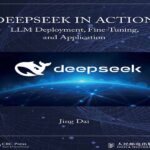- عنوان کتاب: The AI Playbook: Mastering the Rare Art of Machine Learning Deployment
- نویسنده: Eric Siegel
- حوزه: یادگیری ماشین
- سال انتشار: 2024
- تعداد صفحه: 253
- زبان اصلی: انگلیسی
- نوع فایل: pdf
- حجم فایل: 3.81 مگابایت
این کتاب یک کتاب راهبردی و تاکتیکی برای راهاندازی یادگیری ماشین ارائه میکند، یک رشته شش مرحلهای برای اجرای یک پروژه ML به طوری که با موفقیت استقرار یابد. من این عمل را bizML می نامم. در طول مسیر، این کتاب همچنین دانش پیش زمینه نیمه فنی را که همه شرکت کنندگان در پروژه نیاز دارند ارائه می دهد – به روشی دوستانه و در دسترس برای هر کسی که بتواند آن را درک کند. به دلیل این پوشش، کتاب همچنین به عنوان یک مقدمه غیر فنی در این زمینه برای تازه واردان عمل می کند. مشکل اینجاست ML قدرتمندترین فناوری کاربردی جهان است. اما ML تنها می تواند عملیات در مقیاس بزرگ را با تغییر آنها بهبود بخشد. به همین دلیل، یک پروژه ML نباید به عنوان “یک پروژه فناوری” در نظر گرفته شود. در عوض، برای تأثیرگذاری، باید به عنوان یک پروژه تجاری با هدف بهبود عملکرد عملیاتی، با ML به عنوان تنها یک مؤلفه – که ضروری است اما کافی نیست، دوباره چارچوب بندی شود. با توجه به بخش فنی و اجرای آن، صنعت نتوانسته است یک روش تجاری پذیرفته شده برای اجرای نیمه دیگر پروژه موفق ML ایجاد کند. در نتیجه، ابتکارات جدید ML معمولاً اجرا نمیشوند. اصلا. بسیاری از پروژههای ML موفق میشوند، حتی اگر در اقلیت باشند – حتی کسری از پروژههای متعدد این حوزه محبوب هنوز هم زیاد است. علاوه بر این، در شرایط خاصی یک پروژه ML موظف به موفقیت است، مانند پروژه های با اولویت بالا در یک شرکت فناوری بزرگ یا پروژه هایی که برای به روز رسانی یک مدل موجود که قبلاً مستقر شده است. دنیای صنعتی نسبت به ML صعودی باقی می ماند زیرا پتانسیل بزرگ آن دست نخورده باقی می ماند. خیر. هنگامی که یک پروژه ML از bizML پیروی می کند، رویه سازمانی ارائه شده توسط این کتاب، همه افراد درگیر در پروژه به نوعی در آن عمل شرکت می کنند. تنها با آشنایی همگانی با این تمرین سرتاسر – و با دانش پیش زمینه نیمه فنی که آن را هدایت می کند – تیم می تواند مؤثرترین همکاری را داشته باشد. این کتاب به هر کسی که میخواهد با مشارکت در گسترش کسبوکار ML ارزشی کسب کند، خدمت میکند، فرقی نمیکند نقشی را در بخش تجاری یا فنی بازی کنید. اول از همه، من این کتاب را برای متخصصان تجارت نوشتم – افرادی که پروژه ML را اجرا می کنند، در آن سهام دارند، در مورد آن تصمیم می گیرند یا عملیاتی را مدیریت می کنند که توسط آن تغییر (و بهبود می یابد). این شامل مدیران، مدیران، مدیران، مشاوران و رهبران از همه نوع می شود. اما این کتاب برای اهل فن نیز هست. اگر شما یک دانشمند داده، مهندس ML یا هر نوع متخصص فنی درگیر با ML هستید، این کتاب از شما دعوت می کند که از اجرای عملی عقب نشینی کنید و دیدگاه جدیدی در مورد الگوی کل نگر که در آن مشارکت دارید به دست آورید.
This book presents a strategic and tactical playbook for launching machine learning, a six-step discipline to run an ML project so that it successfully deploys. I call this practice bizML. Along the way, the book also delivers the semi-technical background knowledge everyone participating in the project needs—in a friendly, accessible way anyone can understand. Because of that coverage, the book also serves as a non-technical introduction to the field for newcomers. Here’s the problem. ML is the world’s most powerful generally applicable technology. But ML can only improve large-scale operations by changing them. For that reason, an ML project shouldn’t be viewed as “a technology project.” Instead, to make an impact, it must be reframed as a business project meant to improve operational performance, with ML as only one component—one that’s necessary but not sufficient. With the attention overwhelmingly focused on the technical portion and its execution, the industry has failed to establish a widely adopted business practice for executing the whole other half of a successful ML project. As a result, new ML initiatives routinely fail to deploy. Not at all. Many ML projects succeed, even if it’s only a minority—even a fraction of this popular field’s many projects is still many. Moreover, in certain circumstances an ML project is bound to succeed, such as highpriority projects at a Big Tech firm or projects meant to update an existing model that’s already deployed. The industrial world remains bullish on ML because its great potential remains intact. No. When an ML project follows bizML, the organizational practice presented by this book, everyone involved in the project participates in that practice in some way. Only with universal familiarity with this end-to-end practice—and with the semi-technical background knowledge that drives it —can the team collaborate most effectively. This book serves anyone who wishes to gain value with ML by participating in its business deployment, no matter whether you’ll play a role on the business side or the technical side. First and foremost, I wrote this book for business professionals—the people who run the ML project, hold stakes in it, make decisions about it, or manage the operations that will be changed (and improved) by it. This includes executives, directors, managers, consultants, and leaders of all kinds. But this book is for techies, too. If you’re a data scientist, ML engineer, or any kind of technical practitioner involved with ML, this book invites you to step back from the hands-on execution and gain a new perspective on the holistic paradigm within which you are contributing.
این کتاب را میتوانید از لینک زیر بصورت رایگان دانلود کنید:
Download: The AI Playbook: Mastering the Rare Art of Machine Learning Deployment




































نظرات کاربران